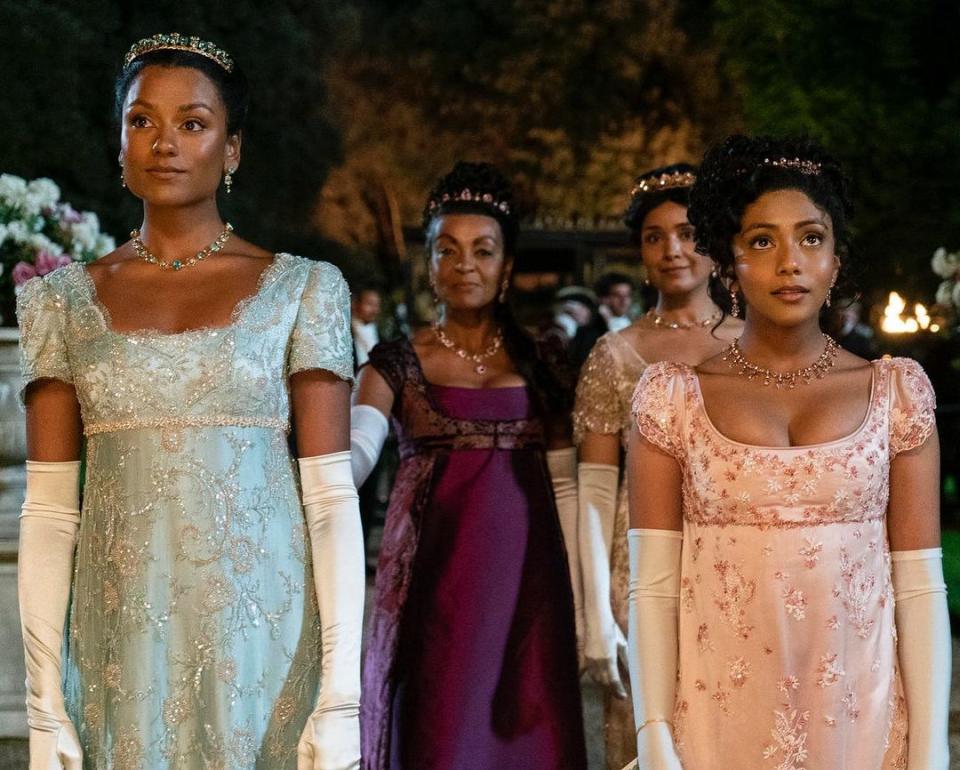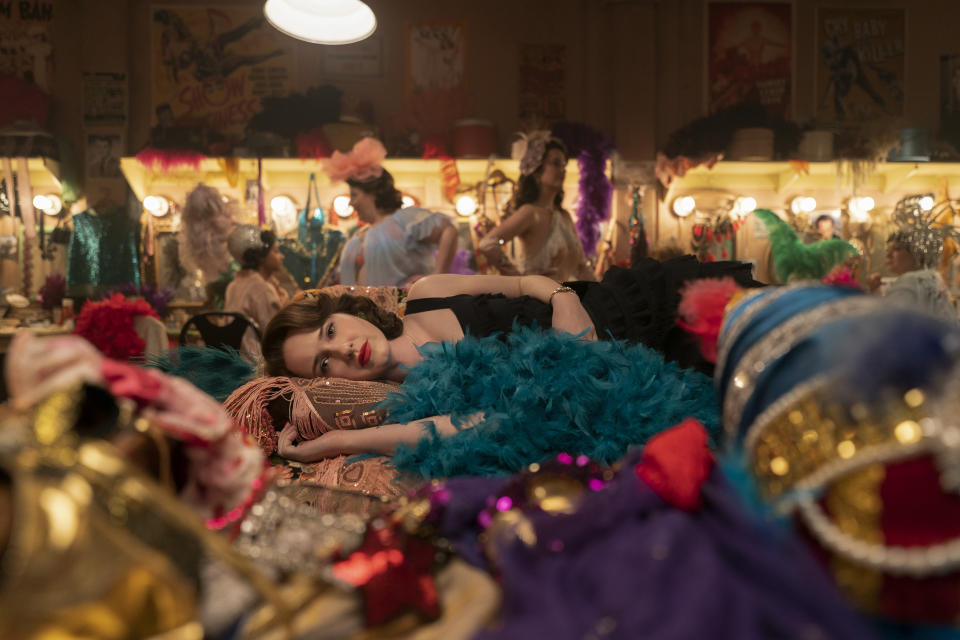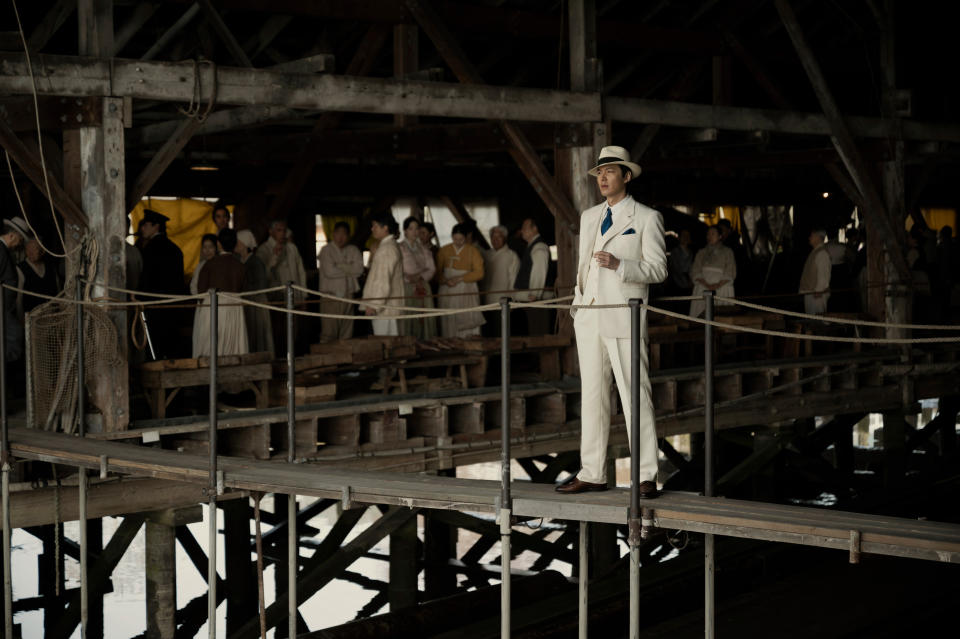Craft Emmy Analysis: In a Year Without a ‘Crown’ or a ‘Queen’s Gambit,’ What Historical Series Will Rule?

There are no clear frontrunners among the historical series vying for this year’s Creative Arts Emmys — where many of the awards honoring artistic and technical achievements in television are specifically geared toward programming with a period setting. In 2021, these categories were dominated by “The Queen’s Gambit,” the Cold War-era chess drama whose nine Creative Arts Emmys included wins for period costume and production design. Elsewhere, the ’70s- and ’80s-set fourth season of “The Crown” bested all dramas, regardless of period and genre, in the areas of cinematography, casting, and editing. But neither Netflix show will defend their titles in 2022: “The Queen’s Gambit” was a limited series, and Season 5 of “The Crown” won’t premiere until November.
In surveying five leading contenders — the returning “Bridgerton” (Netflix), “The Marvelous Mrs. Maisel” (Prime Video), and “The Great” (Hulu), along with well-pedigreed newcomers “The Gilded Age” (HBO) and “Pachinko” (Apple TV+) — the question is: Can one of these step up and reign supreme over crafts?
More from IndieWire
How 'Bridgerton' Showrunner Upped the Ante with Sexy Season 2
'Top Gun: Maverick': How They Shot the High-Octane Cockpit Footage
In terms of popularity, lavishness, and capturing the zeitgeist, “Bridgerton” has the best opportunity. Chris Van Dusen’s sexy and diverse re-imagining of London’s high society during the Regency era of the early 19th century was Netflix’s most watched English-language series in its first season. It captured an impressive eight craft nominations last year (casting, cinematography, period costumes, period or fantasy production design, original score, main title theme music, and music supervision). But opposite “The Queen’s Gambit” and “The Crown,” it only managed a single win, for period hairstyling. Having boosted its popularity and viewership with Season 2, “Bridgerton” has a second chance to shine this season.
But don’t underestimate the staying power of “Mrs. Maisel,” the smart, feminist comedy from showrunners Amy Sherman-Palladino and Daniel Palladino, which garnered 11 craft Emmys its first three seasons (three in 2018, and four apiece in 2019 and 2020). These included three wins for music supervision and two for cinematography, as well as nods for casting, period costumes, editing, hairstyling, non-prosthetic period makeup, and sound mixing. Not suffering a drop off after a two-year hiatus and scoring a new win or two will be the challenge for “Mrs. Maisel.”
The problem for the critically-acclaimed “The Great” was that Tony McNamara’s decadent black comedy about Catherine the Great’s (Elle Fanning) rise to power was shut out of the Creative Arts Emmys its first season. Thus, it has no where to go but up as TV Academy voters re-assess its inventive depiction of 18th century Russia.
Meanwhile, “The Gilded Age” and “Pachinko” must distinguish themselves in a crowded field of historical dramas. Julian Fellowes follows up his phenomenal “Downton Abbey” with “The Gilded Age,” which concerns the industrial boom of 1880s New York and the rise of the nouveau riche. With “Pachinko” (based on Min Jin Lee’s New York Times Best Seller), showrunner Soo Hugh follows four generations of a Korean family across seven decades as they emigrate to Japan and later to the United States. Both shows have plenty to offer in using the arc of history to explore families coping with change and opportunity. This makes them potenitally relevant and relatable to Emmy voters.

Netflix
“Bridgerton”
Where can it gain or lose: It’s time for “Bridgerton” to grab the spotlight after upping its opulence and sex appeal and doubling-down on its anachronistic playlist in Season 2. There’s reason to believe that “Bridgerton” can do better in at least three categories: costume design, production design, and music supervision.
It’ll be tough to repeat in cinematography, though, with such strong competition from Outstanding Drama Series contenders, including HBO’s “Euphoria” and “Winning Time: The Rise of the Lakers Dynasty,” which were both shot on film in innovative ways, and Apple TV+’s buzzy sci-fi thriller “Severance.”
Best bet: “Bridgerton’s” best opportunity is costume design, thanks to the introduction of the Sharma sisters in a romantic triangle with the wife-seeking Anthony Bridgerton (Jonathan Bailey). Costume designer Sophie Canale, who was an assistant in Season 1, took over for Ellen Mirojnick in Season 2, and emphasized more color, fabric, jewelry, and hair elements. Canale used Indian-inspired jewel tones for the headstrong Kate Sharma (Simone Ashley) and the more idealistic Edwina Sharma (Charithra Chandran). Then she contrasted heavy fabrics for Kate with lighter ones for Edwina, applied floral elements to Edwina’s wardrobe, and later switched to lighter fabrics for Kate as she warms up to Anthony.
Other possibilities: Production designer Will Hughes-Jones returned in Season 2 with even more extravagant world building for the balls, teas, and horse races. He once again utilized a massive soundstage outside London for a combination of new and repurposed set builds. In addition, there were nearly 90 new location sets. But historical accuracy be damned: This is about decadent fun and snarky gossip.
Meanwhile, music supervisor Justin Kamps (succeeding Alexandra Patsavas) continued the creative playlist of classically re-imagined pop songs in Season 2 with covers of Nirvana’s “Stay Away” (the Vitamin String Quartet), Madonna’s “Material Girl” (composer Kris Bowers), Pink’s “What About Us” (DUOMO), and Miley Cyrus’ “Wrecking Ball” (Midnite String Quartet).

Christopher Saunders/Amazon Prime Video
“The Marvelous Mrs. Maisel”
Where can it gain or lose: The good news is that Season 4 has two things going for it: a new decade (the 1960s) and a new venue (a burlesque club). It’s about change for stand-up comic Midge (Rachel Brosnahan), who attracts a female audience and can finally be uninhibited in telling dirty jokes about her empowerment.
This offered a shift for the crafts teams in subtle stylistic approaches. As IndieWire’s Jim Hemphill observed, the trio of cinematographer M. David Mullen, costume designer Donna Zakowska, and production designer Bill Groom “retain the vibrant color palette, whirling camera movements, and detailed settings of previous seasons while addressing not only a heroine but an entire culture in a state of transition.”
Best bet: Mullen and Zakowska are firmly established as winners. Mullen lit the scenes by channeling ’60s glam; and Zakowska struck a balance between the ‘50s style of previous seasons and ’60s pop art (riffing off Catherine Deneuve and Brigitte Bardot for Midge’s wardrobe).
Music supervisor Robin Urdang is also a sure bet for a fourth Emmy, diving into 1960 (“Money (That’s What I Want)” from Barrett Strong) while continuing to close each episode with a flash forward (“I Was Dancing In The Lesbian Bar” from Jonathan Richman).
Other possibilities: This could be Groom’s year to finally add a “Maisel” Emmy to the four he won for “Boardwalk Empire.” For the Wolford club and burlesque numbers, Groom and his team constructed the set in a large New York space left over from World War II and authenticated it with an odd assortment of pieces.

Gareth Gatrell/Hulu
“The Great”
Where it can gain or lose: Why was “The Great” overlooked in its first season? Maybe it was too “anti-historical.” Or the shifts in tone weren’t appreciated, including the witty repartee between Catherine and Peter during their sexual escapades. Hopefully, Emmy voters will be seduced enough by Season 2 to give the crafts more respect. If not, that would be a shame.
Best bet: Sharon Long, who replaced Emma Fryer as costume designer in Season 2, has the best shot at an Emmy nomination. She had the extra burden of having to design 18th-century Russian costumes for the faux-pregnant Fanning. She also added subtle refinements to her wardrobe with jewelry and richer silk fabrics, to showcase Catherine’s ruling status. As always, it was a balance between period accuracy and over-the-top revisionism.
Other possibilities: The same was true for production designer Francesca Di Mottola, who paid more attention to the winter palace (a set build on a London soundstage), reshaping it to be darker-looking and continuing to use both Russian and Italian architectural influences. Highlights include the wild baby shower that Peter throws Catherine in his apartments, the nursery, and Catherine’s salon, which all convey the mood swings they encounter throughout Season 2.
Composer Nathan Barr, whose score can best be described as a mashup of Russian classicism and electronic modernism, could also grab a nomination. As IndieWire’s Sarah Shachat noted: “Because Barr has established a sonic language that bends the period without breaking it, he can craft small transitional moments that match each bawdy joke, grand entrance, or silent heartbreak.”

Photographer: Alison Cohen Rosa
“The Gilded Age”
Where it can gain or lose: “The Gilded Age” will have a tough time rivaling “Downton Abbey’s” Emmy craft success. The blockbuster historical drama collected nine crafts awards throughout its six seasons (running the gamut of cinematography, production design, costume design, hairstyling, and original score). However, HBO has put a lot of faith in its pedigree, submitting the historical drama in 15 categories: editing (twice), cinematography (twice), casting, period costumes, choreography, period hairstyling, main title design, period non-prosthetic makeup, original score, main title theme music, music supervision, production design for period or fantasy, sound editing, sound mixing, and special visual effects. But can Fellowes’ new series overcome a tepid reception and tough competition?
Best bet: Production designer Bob Shaw (“The Irishman,” “Boardwalk Empire”) is a strong contender thanks to the beauty and grandeur of the world building of “The Gilded Age,” which included finding period-accurate mansions from the tip of Long Island to Manhattan to Albany, as well as Troy and Tarrytown, NY, and Newport, RI. The art department also constructed a New York City backlot with giant sets, and utilized four different soundstages in two different locations. In addition, they decorated the interiors with fine furnishings and rich architectural craftsmanship. Plus, there was the added color of wooden boats on a pond in the park or the toys kids play with. Horses and carriages had their own level of difficulty for authenticity.
Other possibilities: Costume designer Kasia Walicka-Maimone (“Moonrise Kingdom”) will also compete for a range of period wardrobes that are distinct for their modern and classic values, and for evoking the power of being a woman. The principal costumes were made in New York, using different houses for each main character, and additional clothing makers in Italy, Portugal, and Hungary took care of the rest.
The original score by Emmy-nominated sibling composers Harry Gregson-Williams (“Electric Dreams”) and Rupert Gregson-Williams (“The Crown”) is also noteworthy for combining a chamber orchestra with with a more contemporary approach through such unexpected instrumentation as hammer dulcimer, kantele, and ukulele, as well as an occasional arpeggiated synth element.

Courtesy of Apple TV+
“Pachinko”
Where it can gain or lose: “Pachinko” is the wildcard and could be a craft force to be reckoned with. The series focuses on family matriarch Kim Sunja (played as a child by Yu-na, as an adult by Kim Min-ha, and as a grandmother by Youn Yuh-jung), and jumps back and forth in time as a conversation between the generations. Shot throughout Korea (which also doubled for Japan), as well as in Vancouver, Season 1 has been submitted in 11 craft categories: casting, cinematography, editing, period costumes, main title design, music supervision, period or fantasy production design, score, sound editing, and sound mixing, special visual effects. It could be competitive in most, or just a few, depending on how much viewers are pulled into the family saga.
Best bet: The cinematography of Florian Hoffmeister and Ante Cheng is one of the standouts for its beauty, scope, and immediacy. Most important, it doesn’t visually distinguish timelines. “When you see period pieces, they tend to be inaccessible, they’re presentational,” said director Justin Chon at the IndieWire Consider This FYC Brunch on May 12. “But I wanted the audience to be viscerally living this time. We used anamorphic lenses and handheld cameras to increase the immersion. We wanted it to be relatable and accessible. Anamorphic lenses allow you to get close to the characters but see their environment.”
Production design and costume design are also strong contenders. The sprawling world building of production designer Mara LePere-Schloop meticulously recreates both Korea and Japan with epic visuals and intimate detail, while costume designer Kyunghwa Chae weaves a multitude of wardrobes with impeccable detailing. But the highlight is the traditional Korean hanbok, which represents both social position and marital status, and undergoes an evolution throughout time in all manner of opulence.
Other possibilities: Editing is also notable, especially in “Chapter 7,” which explores the backstory of enigmatic, affluent fish merchant Hansu (Lee Minho, who survives the Great Kanto earthquake of 1923. In fact, the entire episode stands apart visually (shot by Hoffmeister) with more muted colors and 1.43:1 aspect ratio. They were also aided by one-half of a “mirrored set” constructed on two continents to capture the chaos and destruction caused by the earthquake.
Enough can’t be said, though, about the ingenious main title sequence, which serves as a microcosm of family connection. As IndieWire’s Ben Travers and Steve Greene noted, “Creative directors Angus Wall and Nadia Tzuo take full advantage of the show’s electric pachinko parlor set, transforming it into a cross-generational dance floor where the central figures in this decades-spanning saga get to show themselves at their most fundamental.”
Best of IndieWire
Emmy Predictions: Outstanding Documentary or Nonfiction Special
Emmy Predictions: Outstanding Documentary or Nonfiction Series
Sign up for Indiewire's Newsletter. For the latest news, follow us on Facebook, Twitter, and Instagram.

 Yahoo Sport
Yahoo Sport 





































